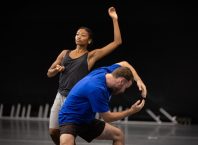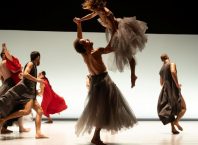Can’t wait for the 50th anniversary production of West Side Story to come to Tel Aviv? The vibrant young cast will soon be here, accompanied by the show’s choreographer, Joey McKneely. There will be 16 performances of the legendary musical at the Israeli Opera from September 2 – 14, with Donald Chan conducting.
McKneely has a special relationship to the musical, having worked intimately with two of the original creators – choreographer Jerome Robbins and playwright Arthur Laurents. Robbins took his idea of setting Shakespeare’s story of Romeo and Juliet within the context of conflicts between teenage gangs to composer Leonard Bernstein and Arthur Laurents. When they were joined by the then young lyricist Stephen Sondheim the four created a landmark in musical theatre history. The collaboration between these great talents produced a show in which the music, lyrics, story and choreography are balanced forces working together, each element enhancing the other.
In a phone interview, McKneely talked about his ongoing romance with the musical. A self-confessed “disco baby” McKneely had no formal dance training but says, “I was always shaking my ass as a kid in the 70s.” Discovering dance at age 17, he was not much more than a kid when he found himself on Broadway a year and a half later, and after the same interval, dancing in “Jerome Robbin’s Broadway,” where he learned the choreography to West Side Story.
Stories abound about Robbins as a harsh taskmaster, fiercely devoted to perfecting his art. McKneely says, “They’re all true. Working with Robbins was a revelation, a learning experience. I had no idea about the history [of West Side Story], I was just a kid. But the choreography made sense to me; I could understand how and why it was done. He was at the end of his career, in his 70s, his temper had diminished. He was somebody who wanted to leave a legacy, to pass that on. That is why I became a choreographer – because of the experience of working with Robbins. Who else was there to work for?”
After 7 years as a dancer, performing in productions such as Starlight Express and Carrie, McKneely turned to choreography. He has worked on diverse projects (including the choreography for the movie Zoolander) and receiving Tony nominations for Smokey Joe’s Café in 1995, and The Life in 1997. In 2000 he both directed and choreographed the La Scala di Milano production of West Side Story, and then for the musical’s 50th anniversary, he was invited to choreograph the Broadway revival alongside Arthur Laurents. McKneely is appreciative of “the good fortune to work with Laurents,” saying, “This gave me another insight – that of the writer’s standpoint – understanding where character comes from.”
Reviving a work still so vivid in cultural memory presents a unique choreographic challenge. As McKneely expressed it, “You have to bring it to 2009 – it’s not 1957 anymore – while staying true to the material.” Always striving to “lift it to a higher standard in terms of the execution, casting, to get the highest quality performance,” he places the emphasis on the emotional aspect of the production because “that is what an audience feels. The storytelling in West Side Story is driven by these kids’ anger, hostility, and violence. They reveal their emotions through the movement.”
In casting the international tour he tried to find “the youngest people possible,” saying, “It’s a story about teenagers. Actors and dancers who are closer to that age have the same hormonal energy – they like to stay out late and party and sometimes get into trouble and fights. When you get older, into your 30s, you think differently, you act differently.”
Working with such young performers requires more than conveying the steps and counts for each number. McKneely says, “They don’t have acting experience. They are skillful in their vocation (singing or dancing), but in terms of acting on this level – they are not trained.” His approach seems to be worlds apart from his mentor Robbins. He seeks to “understand the performer, who they are, their fears, issues. I try to help them become more open emotionally. I get them comfortable expressing their emotions, letting themselves be vulnerable, sharing pain and anger. Help them learn how to access their emotions freely, as themselves, onstage. It’s more of a psychological process.”
When I tell him that I have been watching the 1961 movie to remind myself of the show, he immediately cautions, “Be careful of that,” explaining that there is a vast difference between the film and theatre versions of West Side Story. “The movie is not the stage show. The movie changed the show. Men are not in “America” [the song], Anita was always raped [this is toned down to “almost raped” in the movie]. The movie had to deal with the censors. The movie is an MGM style fantasy. The stage show has more of a sense of reality; there is a naturalism and truth in the environment.”
“Even musically – the ballet doesn’t exist in the movie. The scene which has the cornerstone thematic message [the ballet is set on the song “Somewhere”] – no racism, no ethnic violence, territorial disputes, harmony and peace…a message of hope.”
“The reality of human nature is that we have been fighting with each other since the dawn of time. Based on Shakespeare’s Romeo and Juliet, West Side Story put in the element of race, which is very modern. We’ve made great leaps and bounds but it’s [racial tensions] still very relevant. We’re playing in Israel… I don’t want to get into the whole political issue, but it’s an ongoing issue.”
Having spent 7 years as a dancer, followed by 7 years as a choreographer, the ever-evolving McKneely has now embraced directing as well, giving him a more complete vision of each new work. He is currently working on three new projects, each very different. This is perhaps also due to Robbin’s early influence, who, as McKneely points out, “worked with such a variety: The King and I, Fiddler on the Roof, and West Side Story, all very different, with different vocabulary and characters.” Of the new projects, one is about exotic dancer Josephine Baker, one is about the Empire State Building and the third is a play called “Shadows” with dance.
Does he have a dream project? “Yes,” he responds, and one can almost hear the smile in his voice, “the next one that I’m working on.”
Performances:
September 2 – 14
The Israeli Opera
19 Shaul Hamelech Street
Tickets and info: 03-6927777
www.israel-opera.co.il






